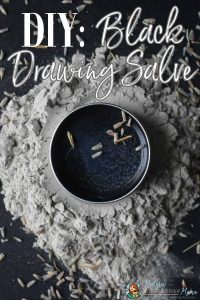Written by Kate Tietje and updated by Sarena-Rae Santos in October of 2023.
This is a very simple salve to make, but a very important one. I knew I needed to add it to my summer first aid kit. You never know when someone will get a splinter, touch a thorny bush, or get a tick bite. That’s where drawing salve comes in.
This drawing salve contains activated charcoal and bentonite clay, which help draw out any poisons, splinters, or other “stuff” that shouldn’t be in the skin. It can help with bug bites and stings, too. Lavender is a great addition because it is generally soothing. It’s very easy to make and something you shouldn’t be without.
Don’t want to make your own? Buy Black Drawing Salve at Earthley, our store! It is made with castor oil, extra virgin olive oil, activated charcoal, bentonite clay, candelilla wax, and lavender essential oil.
Last fall, we had this in our first aid kit when an adult friend said during our hike that she had brushed up against a plant and felt itchy. Right away, a small rash started. We put this salve on it, and she told me later that the rash was gone when we got home! We also used it on chicken pox on our kids later in the fall, and it helped them sleep a little better when the spots were itchy. There are lots of uses for this one!
Black Drawing Salve
Ingredients:
- 1 oz. apricot oil
- 1 tbsp. lavender buds
- 2 tsp. activated charcoal
- 1 tsp. bentonite clay
- 1 tbsp. beeswax
Directions:
Step 1: Mix apricot oil and lavender buds in a small glass container and let it sit overnight to infuse.
Step 2: Strain the oil through a cloth, squeezing it out completely. Discard the herbs.
Step 3: Pour the oil into a clean saucepan and add the beeswax. Turn it on low heat just until it is melted.
Step 4: Remove from heat, add the activated charcoal and clay. Stir until combined.
Step 5: Pour into a 2-oz. tin, or two 1-oz. tins and allow to cool completely.
Once it’s cool, it’s ready to use. Put a lid on it and store it in a cool, dry place. Use in a small amount on splinters, thorns, bites, stings, and even burns. Keep the area clean and dry until the splinter is out.
Note: Store it high if you have little ones! See Everything You Need to Know about Activated Charcoal for tips on how to get messes out and what to do if your little one does get into it!



I’ved used a paste of charcoal. I keep charcoal caps in my purse for internal or external use. This salve is a great idea!
Do you think coconut oil or sweet almond oil would work with this instead of apricot? I already have those two on hand.
Is there a specific purpose for the apricot oil? I have so many other oils, but not this one.
Do I have to use the Lavender? I am allergic to it. If I don’t use it will the salve still work?
I’m wondering if you have a specific pot dedicated to salves and other items like this. I am a beekeeper, so I know from working with wax how hard it is to get off of items. I wouldn’t want to use my normal cookware for beeswax-containing projects. Just wondering how you handle that, along with cleanup. Also, is there anything to consider when sourcing the ingredients you included? Can other oils than apricot be used or is there something that it brings in particular?
Hello, Dani, and thank you so much for your questions. I prefer the double broiler method with wide-mouth mason jars when dealing with wax. When it’s time to clean up, it just takes a little elbow grease and a good scrubbing sponge, but it does get clean. The oils and herbs are interchangeable, but the charcoal is necessary for the drawing effect. Whatever you add to your salve, we recommend cold-pressed oils and non-GMO or organic ingredients. Hope this helps. 🙂